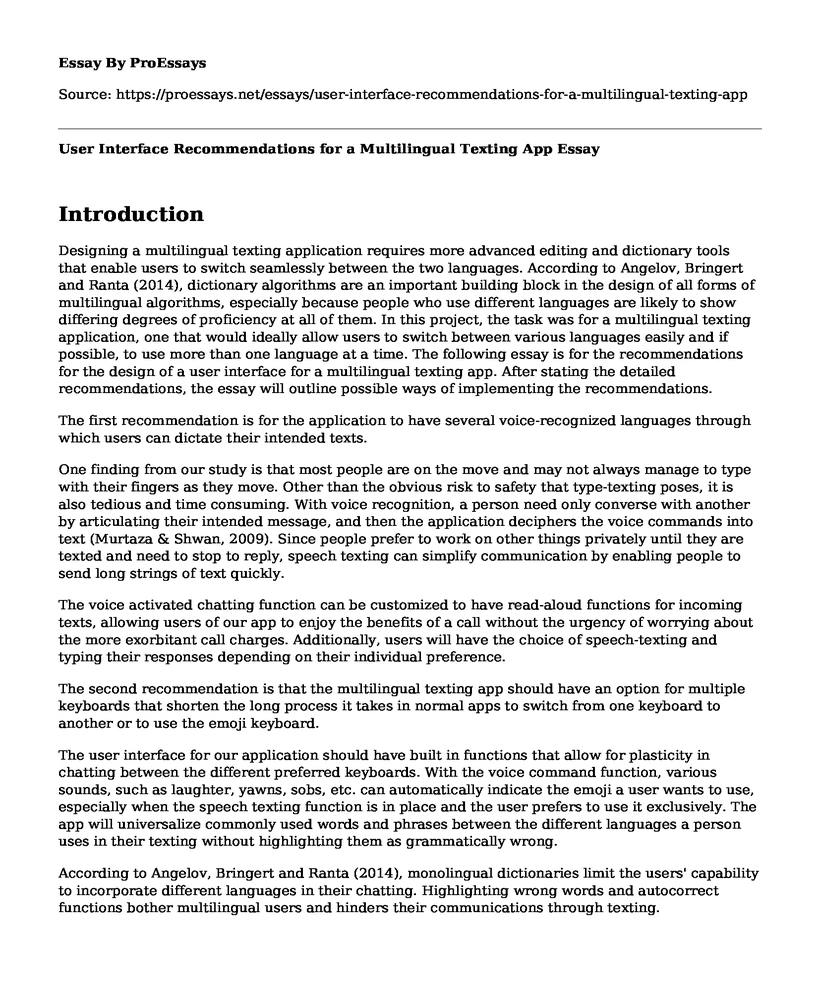Introduction
Designing a multilingual texting application requires more advanced editing and dictionary tools that enable users to switch seamlessly between the two languages. According to Angelov, Bringert and Ranta (2014), dictionary algorithms are an important building block in the design of all forms of multilingual algorithms, especially because people who use different languages are likely to show differing degrees of proficiency at all of them. In this project, the task was for a multilingual texting application, one that would ideally allow users to switch between various languages easily and if possible, to use more than one language at a time. The following essay is for the recommendations for the design of a user interface for a multilingual texting app. After stating the detailed recommendations, the essay will outline possible ways of implementing the recommendations.
The first recommendation is for the application to have several voice-recognized languages through which users can dictate their intended texts.
One finding from our study is that most people are on the move and may not always manage to type with their fingers as they move. Other than the obvious risk to safety that type-texting poses, it is also tedious and time consuming. With voice recognition, a person need only converse with another by articulating their intended message, and then the application deciphers the voice commands into text (Murtaza & Shwan, 2009). Since people prefer to work on other things privately until they are texted and need to stop to reply, speech texting can simplify communication by enabling people to send long strings of text quickly.
The voice activated chatting function can be customized to have read-aloud functions for incoming texts, allowing users of our app to enjoy the benefits of a call without the urgency of worrying about the more exorbitant call charges. Additionally, users will have the choice of speech-texting and typing their responses depending on their individual preference.
The second recommendation is that the multilingual texting app should have an option for multiple keyboards that shorten the long process it takes in normal apps to switch from one keyboard to another or to use the emoji keyboard.
The user interface for our application should have built in functions that allow for plasticity in chatting between the different preferred keyboards. With the voice command function, various sounds, such as laughter, yawns, sobs, etc. can automatically indicate the emoji a user wants to use, especially when the speech texting function is in place and the user prefers to use it exclusively. The app will universalize commonly used words and phrases between the different languages a person uses in their texting without highlighting them as grammatically wrong.
According to Angelov, Bringert and Ranta (2014), monolingual dictionaries limit the users' capability to incorporate different languages in their chatting. Highlighting wrong words and autocorrect functions bother multilingual users and hinders their communications through texting.
Our third recommendation is about the sending of wrong messages that continues to bother users of various messaging apps.
To save our users the trouble of sending correctional texts long after the receiver has already read them, our application will employ artificial intelligence to highlight mistakes before the user sends them. We shall also feature the function to let the sender correct wrongly sent messages and a function that informs receivers of corrected messages on the new status after correction.
The text correction feature will allow users to chat more effectively with each other, allowing them to know when their texts are received, read, being replied to, and when they should change their response because the sender just sent a clarification or correction. The function will foster better communication and reduce misunderstanding.
References
Murtaza, M. & Shwan, A. (2009). Guidelines for multilingual software development. Goteborg: University of Gothenburg Press
Angelov, K., Bringert, B. & Ranta, A. (2014). Speech-enabled hybrid multilingual translation for mobile devices. Gothenburg: 14th Conference of the European Chapter of the Association for Computational Linguistics, 41-44,
Cite this page
User Interface Recommendations for a Multilingual Texting App. (2022, Apr 16). Retrieved from https://proessays.net/essays/user-interface-recommendations-for-a-multilingual-texting-app
If you are the original author of this essay and no longer wish to have it published on the ProEssays website, please click below to request its removal:
- Robots, Smart Materials, and their Future Impact on Humans Essay
- Modern Technology in Judicial Systems: A Critical Analysis Paper Example
- Paper Example on iPhone 7 Just-In-Time: JIT, Dropshipping & VMI Strategies
- Article Analysis Essay on Moped Enabled Mobile Phone Snatches
- Managing Global R&D Projects: Challenges & Innovations - Essay Sample
- Essay Example on Will Humans Win the Race Against Machines? AI and the Digital Revolution
- Annotated Bibliography Sample on Mobile Phones and Social Interaction: A Comparative Study of University Students







